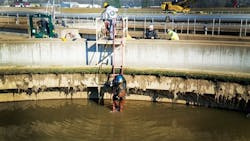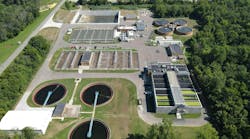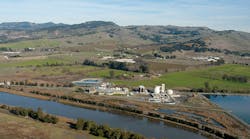Lauren Baltas is assistant editor for W&WD. Baltas can be reached at [email protected] or 847.391.1019.
- Name: Fenton Wastewater Treatment Plant
- Location: Fenton, Mo.
- Size: 6.75 million gal per day
- Infrastructure: Fine screens, grit chamber, primary clarification, plug flow aeration, fine bubble diffusers, secondary clarification, UV disinfection, filter press
The Metropolitan St. Louis Sewer District’s (MSD) Fenton Wastewater Treatment Plant (WWTP) has a complicated relationship with the nearby Meramec River. The facility relies on the river as an outlet for its treated effluent, but in late 2015, the river flooded the plant and it had to halt all operations. As part of MSD—the fourth largest sewer district in the country—the Fenton WWTP needed to get back up and running, and fast.
Treatment Process
Constructed in 1998, the Fenton WWTP is one of seven facilities in MSD, which serves St. Louis County and the city of St. Louis. With an average daily flow of 4.5 million gal per day, the Fenton facility may be the smallest of the seven, but approximately 55,000 people in the primarily residential city of Fenton, Mo., and its adjacent areas rely on it.
A conventional activated sludge facility, the Fenton WWTP utilizes a 14-hour treatment process. Flow travels through fine screens, a grit chamber and primary clarification. It then travels through plug flow aeration, fine bubble diffusers and secondary clarification. During disinfection season, the flow undergoes ultraviolet (UV) treatment. Finally, the Fenton WWTP dewaters sludge onsite using a filter press, and the sludge is disposed of either in a landfill or by incineration at a larger MSD facility. The facility’s effluent flows into the Meramec River.
“We get a very clear effluent,” said Todd Heller, operations division manager for MSD. “The design works very well for the facility.”
Operations at the Fenton WWTP halted when heavy rainfall in December 2015 flooded the facility.
Odor Obstacles
Because the facility sits adjacent to Fenton, odor control is a regular concern. In 2005, the Fenton WWTP underwent a significant upgrade, adding a new fine screen, converting the oxidation ditch to plug flow aeration, introducing two final clarifiers and installing odor control. The odor control helps minimize the facility’s impact on nearby neighborhoods.
Sludge disposal presented new odor issues. While the facility has two sludge disposal options, it primarily relies on incineration. Neighboring residents are sensitive to odor, and the landfill is as well.
“Our sludge is very odorous,” Heller said. “When we disposed of it in a landfill, they were having issues with odors, not only from our sludge, but also from other issues in the landfill. So, we directed our sludge to incineration to help the landfill and mitigate some odor issues.”
Despite challenges with odor, the Fenton WWTP rarely faces large obstacles. “We get a pretty stable flow; it’s mostly domestic flow—we don’t have any large industrial contributors that are influent,” Heller said. “The plant runs really well for us.”
River Woes
In late December 2015, the St. Louis area experienced heavy rainfall on and off for several days, causing the sewer system to become overcharged and the Meramec River to rise. The Fenton WWTP began to flood.
The facility lost operation of its electrical system, losing its influent system and the ability to pump water into it. “It was a total loss at the time,” said Sean Hadley, public information specialist for MSD.
After six days, the WWTP began using temporary influent pumps, and after 12 days it began pumping sewer discharge straight to the river. “We were able to get our own pumps back in operation at Fenton, and [we were] pumping water basically out of the sewers and straight through the plant. [We were] not really processing the water,” Heller said.
The MSD team focused on getting the sewer collection system working, then directed their attention to the primary and secondary systems. Some equipment, like the UV disinfection, took months to get back online. Slowly, the facility began to meet its effluent limits.
“We brought in load after load of microorganisms from one of our functioning plants,” Heller said. “We seeded the Fenton plant with those microorganisms and that allowed us to jumpstart the process.”
After nearly 1,900 man hours and $7.5 million, the WWTP was back up and running in early April 2016. “We were almost like a well-oiled machine,” Heller said. “It was a huge team effort.”
Now, MSD is considering how to prevent facility shutdown should the Meramec River flood in the future. “We’ve got several things underway for mitigation efforts,” Hadley said. “We’re raising the berms at the Fenton facility, and we’re looking at providing some kind of gate to isolate the plant from influent sewers. And if it happened again, we’ve done more than rehearsed it. We would know what to do.”
The plant is prepared for future flooding.


